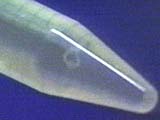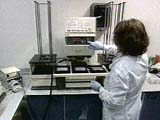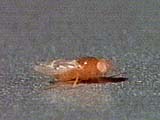Scientists publish findings of human genome project
WebPosted Mon Feb 12 13:27:02 2001
WASHINGTON-- The race to be the first to
map the entire sequence of the human genetic code is over, and it appears to be
a tie.
Two separate groups of scientists have been trying to decipher the DNA code
that makes each of us unique.
Now both say they have completed the initial sequence of the code, and will
publish their findings in the rival publications Science and Nature.
The so-called Human Genome Project has been touted as having the potential to
revolutionize science and medicine.
Last summer when scientists announced they had successfully mapped 97 per
cent of the DNA sequence, world leaders declared it a great day in the history
of the human race.
To the average person, the DNA code, or genome, is a meaningless string of
letters. But to scientists, those letters hold the secret to understanding how
humans are put together.
3.1-billion
letters of DNA
It's a lot of information to decipher. Every human body has 100-trillion
cells, and each cell has 3.1-billion letters of DNA code.
To put that in some kind of perspective, if all the strands of DNA in the
human body were put end to end, they would reach to the sun and back more than
600 times.
Or, if all the DNA information in each body was put in a book, it would fill
200 large telephone directories.
Both groups said they found some of their findings surprising.
They discovered humans have far fewer genes than expected – about the same
number as a fruit fly. But they say humans do a lot more with their genes.
Men more
likely to mutate
They also discovered genetic mutations are twice as likely in men as in
women, because they're found on the Y chromosome.
And they found that some 200 human genes apparently arose from genes that
were somehow inserted into our early ancestors by bacteria.
Both groups made the same discoveries using different methods.
The study in Nature was done by the publicly-funded International Human
Genome Sequencing Consortium, which began a decade ago and involved scientists
from around the world .
The study published in Science was done by the American biotechnology firm
Celera Genomics, which only began its work three years ago.
 The
small, white coil is DNA
The
small, white coil is DNA
For example:

Lab equipment used to sequence
DNA

Humans have about as many genes
as a fruit fly
Copyright © 2000 Canadian
Broadcasting Corporation - All Rights Reserved